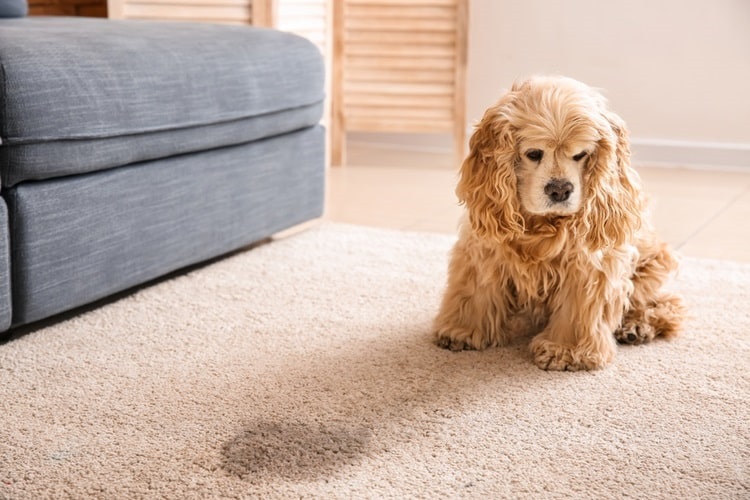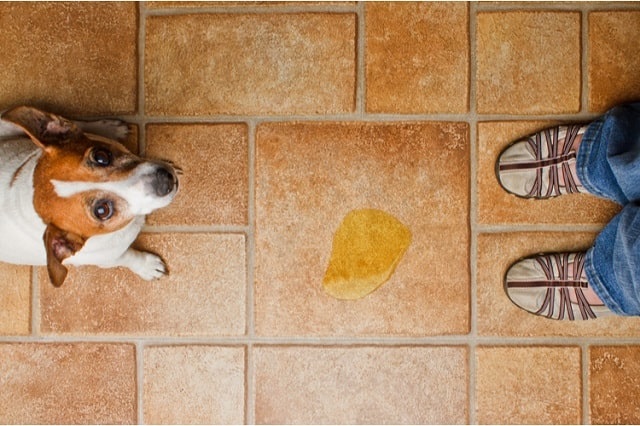Urinary incontinence is a tough problem for dog owners, so it’s not uncommon for pet owners to ask how to treat urinary incontinence in their dog. Constantly cleaning up after your dog gets frustrating and exhausting. Even patient owners may find themselves getting angry. However, a better understanding of the causes behind the condition can lead you to treatments that offer the best outcome for your dog.
What is Incontinence in a Dog?
Incontinence is different from typical marking or lack of house training. Canine urinary incontinence is an involuntary loss of urine.1 The dog doesn’t even know it’s happening. If your dog urinates frequently and tries to make it outside but doesn’t succeed, you’re potentially looking at different issues like a urinary tract infection, pelvic bladder, excessive marking, or ectopic ureter.2
With urinary incontinence, the dog’s not necessarily walking around leaking urine, though that can happen. It’s more common to find the urine after the dog’s been lying down or resting, so the dog bed or couch are likely spots. No matter where it is, the dog has no idea that he’s been leaking. Consequently, it’s not a problem he can control without help.3
Urinary Incontinence Causes
A number of different medical conditions and issues can cause urinary incontinence. Before calling the veterinarian, take note of where and how much pee you find. Watch your dog urinate, looking for any behaviors that offer clues. Does the dog seem to be in pain? Is he starting and stopping frequently? Does he urinate and then a few seconds or minutes later do it again? Is he drinking more than usual?
All of these questions can help determine the condition behind urinary incontinence. Some of the culprits could be:
- Urinary tract infection4
- Bladder stones5
- Diabetes6
- Cushing’s disease7
- Kidney failure8
- Spinal cord damage or disease9
- A defect in the ureter10
- Weak bladder sphincter11
With the help of your veterinarian and a close watch on your dog’s behavior, you can put your dog on a path to better health.
How to Treat Urinary Incontinence in Your Dog
If you suspect urinary incontinence over a relapse in house training or inappropriate urination, head to the veterinarian armed with key observations about when, where, and how much urine your dog is leaking.
From there, the vet will do a physical examination and perform diagnostic tests to narrow down a diagnosis. Your veterinarian may recommend blood work, a urine culture, and x-rays or an ultrasound. The vet may require a few more tests to eliminate some possibilities or get more behavioral history details to eliminate others.
Once she has a better idea of the cause of urinary incontinence, treatment can begin.12 Treatments may include:
- Antibiotics
- A change in diet
- Hormonal medications to help with sphincter control
- Pain medication (until the primary cause can be fully treated)
- Surgical interventions
If your dog has a recessed or hooded vulva, surgery may be necessary to help change the anatomic position and resolve the urinary incontinence.
Changes in diet or medication may take some time to stop urine from leaking. In the meantime, you can track down the best waterproof dog bed you can find or use pee pads throughout the house to catch leaking urine. Bathe your dog more often. Urine can soak the hair and cause skin irritation.13
Canine Urinary Incontinence FAQs
How can you tell the difference between incontinence and inappropriate urination?
Sometimes it’s hard to tell the difference between urinary incontinence—when the dog doesn’t have control over his bladder—and inappropriate urination—the dog has control but isn’t going in or at the right place and time.14
The following are signs of inappropriate urination rather than urinary incontinence:
- An overly excited or anxious dog who urinates when they’re overstimulated.
- The dog is overly submissive, causing him to urinate in your presence.
- You have an older dog. Older dogs may become confused or disoriented, losing the ability to recognize when and where to urinate.
- Arthritis or another physical ailment causes pain that makes it difficult for the dog to make it outside before urinating.
- Non-neutered or spayed dogs, especially males, may perform excessive marking.
- Lack of or not enough time for house training can lead to inappropriate urination. In this case, use positive reinforcement and consistent house training to solidify good urination habits.
Can you help your dog strengthen a weak bladder?
It depends on what you consider a weak bladder. Puppies and dogs in the middle of house training have to learn to hold their bladder until they’re outside. This is part of house/crate training that takes longer with some dogs than others. If you’re in this process, consistent, positive reinforcement offers the easiest solution.
However, a weak bladder may be part of urethral sphincter mechanism incontinence (USMI).15 The dog may be able to control their urine sometimes and not others or may leak in between trips outside. It’s a common condition in neutered and spayed dogs, particularly females.
Medication is the most common initial treatment. Depending on the dog and other indicating factors, the vet may prescribe estrogen for females or testosterone for males.16 Other cases may require surgery. However, everything from the dog’s weight to the age when neutered can contribute to USMI.
Again, a waterproof dog bed can help while you figure out a solution. If you share a bed with your pup you can consider waterproof liner and the best elevated dog bed you can find to have next to your bed. The same can go for the best dog sofa bed if you want to keep your pooch next to you on the couch. And of course if you aren’t worried about it being too cold for your dog to sleep outdoors you could use waterproof liners with the best outdoor dog bed for your pup. You can also try dog diapers to save yourself some work. However, talk to the vet to determine if medication or surgery can help.
Are certain dogs or breeds prone to urinary incontinence?
Small breeds tend to develop incontinence issues more often than larger breeds. However, some breeds, like the golden retriever, Siberian husky, and labrador retriever, are at higher risk for developing problems like an ectopic ureter.17
Final Thoughts
It can be frustrating and exhausting to manage a dog with urinary incontinence. However, with proper veterinary care and a heavy dose of patience, incontinence problems can be treated so that the dog and owner can have a happy outcome.
Article Sources
Pet News Daily uses only high-quality sources, including peer-reviewed studies, to support the facts within our articles. Read our editorial process to learn more about how we fact-check and keep our content accurate, reliable, and trustworthy.
- Reichler IM, Hubler M. Urinary incontinence in the bitch: An update. Reproduction in Domestic Animals. 2014; 49(s2): 75-80. doi: 10.1111/rda.12298
- Byron JK. Canine Urinary Incontinence. Dvm360.com. Published July 3, 2018. Accessed March 28, 2021.
- Hunter T, Ward E. Urinary Incontinence (Urethral Incontinence) in Dogs. Vcahospitals.com. Accessed March 28, 2021.
- Windahl U, Holst BS, Nyman A, Gronlund U, Bengtsson B. Characterisation of bacterial growth and antimicrobial susceptibility patterns in canine urinary tract infections. BMC Veterinary Research. 2014; 10. Published September 24, 2014. Accessed March 26, 2021.
- Medoza-Lopez CI, Del-Angel-Caraza J, Quijano-Hernandez IA, Barbosa-Mireles MA. Analysis of lower urinary tract disease of dogs. Pesquisa Veterinaria Brasileira. 2017; 37(11). doi: 10.1590/s0100-736×2017001100013
- Kumar, P, Kumari RR, Kumar M, Chakrabarti A. Current practices and research updates on diabetes mellitus in canine. Veterinary World. 2014; 7(11): 952-959. doi: 10.14202/vetworld.2014.952-959
- Kemppainen RJ, Peterson ME. Animal models of Cushing’s disease. Trends in Endocrinology & Metabolism. 1994; 5(1): 21-28. doi: 10.1016/1043-2760(94)90117-1
- Polzin DJ, Osborne CA, Adams LD, O’Brien TD. Dietary management of canine and feline chronic renal failure. Veterinary Clinics of North America: Small Animal Practice. 1989; 19(3): 539-560. doi: 10.1016/S0195-5616(89)50060-3
- Granger N, Olby NJ, Nout-Lomas YS, et al. Bladder and bowel management in dogs with spinal cord injury. Frontiers in Veterinary Science. 2020; 7(583342). doi: 10.3389/fvets.2020.583342
- Hunter T, Ward E. Urinary Incontinence (Urethral Incontinence) in Dogs. Vcahospitals.com. Accessed March 28, 2021.
- Noel S, Claeys S, Hamaide A. Acquired urinary incontinence in the bitch: Update and perspectives from human medicine. Part 2 The urethral component, pathophysiology and medical treatment. The Veterinary Journal. 2010; 186(10): 18-24. doi: 10.1016/j.tvjl.2010.06.011
- Byron JK. Urethral Incompetence in Dogs: Updates in Management. Todaysveterinarypractice.com. Accessed March 28, 2021.
- Animal Hospital of North Asheville. Urinary Incontinence in Dogs. Ahna.net. Published March 30, 2020. Accessed March 28, 2021.
- Granson H. Urinary incontinence in companion pets and how it’s different from inappropriate urination to a UTI. Urbananimalveterinary.com. Published April 20, 2020. Accessed March 29, 2021.
- Ponglowhapan S, Khalid M, Church D. Canine urinary incontinence post-neutering: A review of associated factors, pathophysiology and treatments. Thai Journal of Veterinary Medicine. 2012; 42(3): 259-265. Accessed March 26, 2021.
- Brooks M. Urinary Incontinence in Dogs and Cats. Veterinarypartner.vin.com. Published September 6, 2004. Updated November 25, 2020. Accessed March 29, 2021.
- Chew DJ, DiBartola SP. Urinary incontinence in dogs—diagnosis and treatment. World Small Animal Veterinary Association World Congress Proceedings. 2007. Accessed March 26, 2021.


